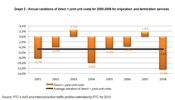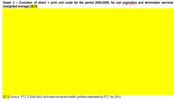Estimates presented by PTC
PTC estimates that the unit cost for interconnection services in 2010 is similar to the one reported in 2008, having based the price proposal presented (which is analysed below) on the cost accounting information for 2008.
The incumbent declares that the forward-looking cost-accounting model for 2010 has not been finalised yet, and that at the moment only results for the 1st half of 2009 are available, which show an increase relatively to 2008, as a result of the increase of staff costs. Without prejudice, PTC refers that it is likely that unit costs of call origination and termination services show a decrease during the 2nd half of 2009, and estimates that unit cost for 2009 will near values achieved in 2008, referring that the company expects no significant changes in 2010 relatively to 2009, for which contributes the fact that the increase of factor prices resulting from inflation is offset by efficiency gains obtained in the meantime.
PTC further refers, in regards to the cost of capital scenario used to justify prices, that in its opinion, costs which result from the enhancement of cost of capital, according to values of the various stages of company privatization, should be used, as these costs reflect appropriate capital remuneration. Without prejudice, and taking into consideration ICP - ANACOM’s views on this issue, given on previous occasions (namely in the scope of previous determinations concerning amendments to the RIO), PTC has based its price proposal on costs determined through book value 1 enhancement of cost of capital.
Therefore, unit costs estimated by PTC for call origination and termination services for 2010 are presented in summary in the table below.
|
|
2010 |
||||
|
Local |
Simple tandem |
Double tandem |
Weighted total |
||
|
Origination |
|
|
|
|
|
|
Termination |
Fixed origin |
|
|
|
|
|
Mobile origin |
|
|
|
|
|
|
Weighted average |
|
|
|
|
|
|
Interconnection Total |
|
|
|
|
|
[ECI] Figures in Euro cents.
Source: PTC estimates.
PTC mentions that it has been reducing its costs, specially operational costs; nevertheless, it stresses that a network operator’s cost structure is characterized by a high fraction of fixed costs, which on account of their own nature have not decreased at the same rhythm of traffic using PTC’s network.
As regards the impact of measures adopted in the scope of PTC’s human resources policy (in terms of curtailment), PTC refers that, although such measures correspond to a business rationalisation and restructure investment, the depreciation of which is compensated by the reduction of staff costs and by the flexibility and use of available global resources, the hiring of resources with the necessary skills entails an average cost per worker higher than the average cost from which the company is relieved with each person made redundant in the scope of the restructure process, which limits the decrease of staff costs achieved with the ongoing curtailment efforts.
ICP-ANACOM’s analysis
In order to assess whether it was reasonable to use the assumption adopted in previous years, of a 5% annual reduction of direct and joint unit costs, the annual average variation of direct and joint unit costs of the origination and termination services was analysed. As shown on the following graph, the evolution of these costs during 2000-2008, according to PTC’s AAS results for that period (and taking into account traffic profiles foreseen for 2010) represents a -4.8% average variation for services under analysis (specifically, -5.7% for call origination and -4.3% for call termination).
Graph 2 - Annual variations of direct + joint unit costs for 2000-2008 for origination and termination services
Therefore, and given the available historical data, the assumption of a 5% annual reduction of direct and joint unit costs, which for several years now has been used to establish RIO prices, is deemed to remaintain appropriate.
In the light of the above, cost estimates presented by PTC for 2010, the values of which are similar to those reported in 2008, do not seem to appropriately reflect the historic evolution of unit costs, nor the annual decrease of unit costs resulting from the operation of an efficient provider. It is noted, moreover, that in 2008 the reduction exceeded 10%.
In regards to common costs, and as referred by ICP-ANACOM on previous occasions (namely in the scope of RIO analyses), it is considered that the variation at the level of common costs reflects mainly PTC’s management policies, not costs that are directly incurred as a result of the provision of specific services. In particular, the level of common costs may be affected by management decisions adopted by PTC in a specific year, thus becoming an uncertainty factor to which alternative operators who purchase interconnection services from PTC may be subject.
Therefore, as there is no reason to make alternative operators subject to any instability due to changes in PTC’s internal management (as they would be subject to variations in their inputs costs on account of PTC’s internal issues and not as a result of market forces or service evolution), it is deemed that the fluctuations of common costs not specifically associated to the interconnection service provision should not have any impact at the level of interconnection prices applied.
Moreover, it is generally accepted at international level that common costs represent around 10% of total costs, as provided for, in fact, in Commission Recommendation of 08.04.1998 2 (which has been updated in the meantime) on interconnection in a liberalised telecommunications market (Part 2 - Accounting separation and cost accounting), which refers that a well defined cost-allocation system will enable at least 90 % of the costs to be allocated on the basis of direct or indirect cost-causation, in efficient terms and in a long-term approach.
In the light of the above, it is restated that the establishment of interconnection prices must only take direct and joint costs into consideration, allowing notwithstanding a final margin which may remunerate ongoing common costs.
Therefore, ICP - ANACOM, based on the 2008 AAS results, and assuming a 5% annual reduction of direct and joint unit costs, estimated costs for 2010, deeming such assumption to accurately represent the annual decrease of unit costs resulting from the operation of an efficient provider, and the necessary efficiency incentive. The Authority takes also the view, notwithstanding PTC’s comments on the effects of the curtailment policy adopted over the last few years, that it also expects such a policy to translate into an efficiency increase, which will certainly have an effect on unit costs associated to services at stake.
Accordingly, the results achieved are presented in the table below. Note that the AAS 2008 results used in the analysis were adjusted by that company to reflect the costs that would result from the cost of capital achieved according to the method used in 2004 and previous years, without the reclassification of pre-selection fixed assets introduced by PTC in the AAS results for the 2004 financial year, as referred in the assessment supporting determination of 23.12.2005 3, on the draft decision on amendments to RIO 2006.
|
Services |
2010 |
|||
|
Local |
Simple Tandem |
Double Tandem |
Weighted Total |
|
|
Origination |
|
|
|
|
|
Termination |
|
|
|
|
|
Interconnection total |
|
|
|
|
[ECI] Figures in Euro cents.
Source: ICP-ANACOM estimates.
It should be noted that, as referred above, this analysis is based on the traffic profile estimated by PTC for 2010, for average call duration and distribution of traffic according to different interconnection levels and time periods.
It is considered that costs thus estimated make it possible to take into account the historic evolution of direct and joint costs, as well as the likely cost reduction associated to the development of the activity of an efficient operator. The following graph represents the evolution of direct and joint unit costs associated to interconnection services (weighted average of call origination and termination services).
Graph 3 – Evolution of direct + joint unit costs for the period 2000-2008, for call origination and termination services (weighted average) [SCI]
In view of the above, this analysis will thus adopt estimates prepared by ICP - ANACOM, which take into consideration the historical evolution of direct and joint costs and the expected cost decrease associated to an efficient operator’s business development.
1 As referred, PTC submitted estimates based on the methods of enhancement of cost of capital according to (i) values of stages of privatization; and (ii) book value. As far as the methods of enhancement of cost of capital are concerned, ICP - ANACOM’s position to consider solely book values was conveyed to PTC in previous assessments, and this view is again restated herein. Therefore, the present analysis only presents figures submitted by PTC based on the method of book value enhancement of cost of capital.
2 Commission Recommendation 98/322/EC, of 8.4.1998https://www.anacom.pt/render.jsp?contentId=988234.
3 Alterations to be adopted in the scope of the RIO 2006 (draft decision)https://www.anacom.pt/render.jsp?contentId=418512.






